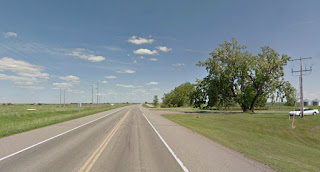Dec 11 – In searching for the beautiful purple springs of my imagination, I
learned about the Purple Springs Provincial Grazing Reserve, the first
irrigated reserve in Alberta in 1957. The goal was to help establish viable farms in
the area. I thought it was an
interesting idea of communal responsibility for rural land management.
A 2008 report from Alberta Sustainable Resource Development describes
the land and how it is being used:
The reserve is located in the dry mixed grass subregion of
the grassland natural region and covers 6,684 acres of level to gently rolling
land. There are about 1,100 acres of flood irrigation located in two pastures.
One is at Grassy Lake, and the other is at Purple Springs. The St. Mary River
Irrigation District and the Taber Irrigation District service these pastures.
The remaining 5,584 acres consists of 2,000 acres developed tame pastures and
3,584 acres of native grasslands.
On April 1, 1998, The Purple Springs Grazing Association
negotiated a renewable management agreement with the government to assume all
aspects of livestock management on the reserve. The management agreement requires
the association to maintain the fences, dugouts, corral sites and buildings at
the headquarters. Although the reserve is quite small in area, it requires two
corral systems because the reserve has two separate parcels, divided by the CPR
tracks and Highway No. 3. This makes it impractical to move animals from one
parcel to the other.
In 2004, the grazing association began a project to upgrade
the flood irrigated fields by replacing open ditches with 1.5 miles of gated
pipe.
In a normal year, the reserve can graze 1,300 head of
livestock for a five month period from mid-May to mid-October. Red Angus and
Charolais breeds are run on the reserve. In 2005 the association started to
provide the bulls for the breeding programs.
Fall and winter months provide recreational opportunities
for pheasant hunting, cross-country skiing and snowmobiling. Access routes have
been provided for those wishing to visit the reserve.
And – finally! – I got a hint about those purple
springs.
Maybe the early explorers &
namers saw this area in high summer when some of the low-lying ponds were
surrounded by wildflowers in bloom? My
personal nominees for adding purple to the prairies: showy locoweed.
















































